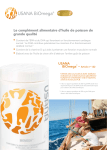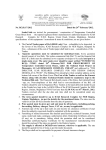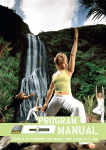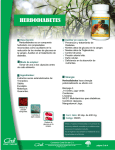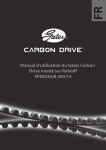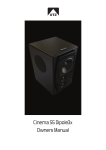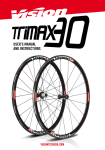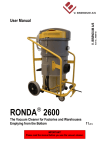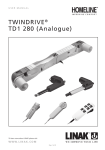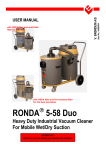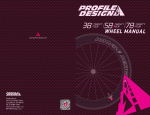Download technical data
Transcript
MANUAL FURNITURE FOR LOCOMOTION WWW.BIOMEGA.COM [email protected] BIOMEGA – FURNITURE FOR LOCOMOTION Congratulations on the purchase of your new Biomega bike. This manual will assist you in setting up and maintaining your bike. Read it through carefully in order to familiarise yourself with your new bike. And remember that proper maintenance and adjustment will enhance performance and comfort over time. WARNING: To avoid injury, read all manuals and instructions before you take your first ride. Store this bike user manual in a safe place. P. 1 THE MANUAL This bike is for on-road use only. Do not use the bike off-road or on rough terrain. Inspect the entire bicycle before riding. Ensure before riding that there are no loose parts, bolts or screws. If you have any doubts or questions, contact your local bike dealer. General bike safety practices: 1. Always follow the traffic laws in your country. 2. Never ride while under the influence of alcohol, medication or drugs. 3. If you suffer from any health conditions, please consult your doctor before riding. 4. Always remember to wear a helmet while riding. 5. Never endanger yourself or others by reckless riding. By not following these safety precautions, you may risk injuring yourself or others. P. 2 GET STARTED WITH YOUR NEW BIOMEGA BIKE. ADJUSTMENTS BEFORE YOUR FIRST RIDE Before taking your new bike on your first ride, it is important for your own comfort and for your safety that you adjust your bike. SADDLE In order to fit your bike to your size and taste, please follow these instructions: Adjust the seat height by loosening the seat clamp bolt by using a 5mm Allen key. Set the seat height to an approximated height, and tighten the seat clamp. Get on. If the height is correct, your heel should be able to just reach a pedal in its lowest position; make sure you keep your hips horizontal while doing this. To avoid injury to your hips and knees, it is important that you get it done right. Take your time. Now you can adjust the seat back and forth and angle it to get the right distance between seat and handlebars. WARNING! Make sure that all bolts that you have loosened are tightened again. WARNING! Never raise the seat post above the limit marked on the seat post. HANDLEBAR Depending on your model of bike, there are several ways to adjust your handlebar. HOW TO MOUNT FRONT WHEEL 1. Remove plastic spacer in the brake caliper between the brake pads. (1) 2. Align the hub/wheel correctly with the fork (2). 3. Mount the front wheel on the fork. Be sure to align the hub disc rotor (3 a) to slide in between the brake pads (3 b) on the brake caliber (3 c) when you mount the front wheel onto the front fork. Mounting the wheel and disc brake rotor wrong might cause personal injury when riding and damage the disc brake. P. 3 4. When the disc brake is properly aligned and the fork is sitting on the axle; first put the supplied washer (4 d) outside the fork and then the hub nut (4 e) outside the washer. 5. The hub nut is then tightened firmly with an 8mm allen key. 1 2 3 c ! b b a b a 4 5 d e P. 4 BOS/BOSTON Adjust the handlebar height by loosening the stem. Carefully loosen the two bolts on the side of the stem with a 6mm Allen key. Then use a 14mm spanner and loosen the top bolt. You can now align the stem with the front wheel. When finished, retighten all bolts. The handlebar can be tilted forwards or backwards. Loosen the four bolts on the front of the stem, and tilt the bar forward or backwards. When you have found a suitable position, retighten the bolts. NYC/NEW YORK To align the handlebar with the front wheel, loosen the stem clamp bolt situated on top of the handlebar with a 5mm Allen key. Align the handlebar with the front tire; retighten the stem clamp bolt hard enough so you cannot turn the handlebars when you are holding the wheel between your legs. It is possible to raise the handlebar on a New York. You can order a steering tube adapter e.g. made by BBB (www.bbbparts.com). The size you need is the following: BHP-20, size: 25.4/22.2. However be aware that any accidents or problems from raising the handlebar are NOT COVERED BY THE WARRANTY. STEM AND HEADSET Depending on your bike, there are several ways to adjust your stem and your A-headset BOS/BOSTON Carefully loosen the two bolts on the side of the stem with a 6mm Allen key. Then use a 14mm spanner and loosen the top bolt. You can now align the stem with the front wheel. When finished, retighten all bolts. NYC/NEW YORK To align the Biomega stem with the front wheel, loosen the stem clamp bolt situated on the side of the stem with a 5mm Allen key, align the stem with the front tire, retighten the stem clamp bolt hard enough so you cannot turn the handlebars when you are holding the wheel between your legs. LOOSE A-HEADSET If you experience a loose A-headset or your stem is out of alignment with the front wheel, the procedure is as follows: loosen the bolt that is placed on the side of the stem (stem clamp bolt), where it clamps the stem to P. 5 the steering tube. Then turn the A-headset tension bolt placed on top of the stem, half a turn clock-wise at the time, until there’s no play, when rocking the bike back and fort while blocking the front brake.. Now you align the stem with the front wheel and retighten the stem clamp hard enough so you cannot turn the handlebars when you are holding the wheel between your legs. Retighten all loose bolts. ADJUSTING A-HEADSET If your handlebar is resisting when you are turning, it is probably because your A-headset is too tight. In that case you should loosen the stem clamp bolt and turn the A-headset tension bolt (situated on top of the stem) counter clockwise, but be careful not to loosen it too much as that will give loosen the A-headset system. Remember not to operate headset-tension bolt unless the stem clamp bolts have been loosened. Retighten all loose bolts. WARNING! To avoid injury, always ensure that the stem and handlebar are positioned and tightened properly before riding the bicycle. PEDALS The pedals are clearly marked with “L” for left and “R” for right on the threads. The right pedal is assembled in a clockwise direction, using a 15mm wrench. The left pedal is assembled in a counter-clockwise direction. The pedals are not interchangeable. Tighten well, but do not use excessive force. Always make sure the pedals are tightly screwed onto the crank arm to avoid losing control and causing injury to you and the bicycle. BRAKES Biomega bikes are equipped with quality Shimano hydraulic disc brakes. We recommend you study the Shimano disc brake manual found inside the box with your bike. WARNING: Always check your brakes before you ride your bike. Ensure that they are working properly. Failing to do so may result in injury and serious damage. Disc brakes have powerful braking ability and should be used with moderation and care. Never use unnecessary force to pull your brakes when you are riding. Please note that the disc can get very hot and should not be touched immediately after use. Never use anything else than water to P. 6 rinse your brakes. Never use soap, oil or any other kind of lubricant. CLEANING YOUR BRAKES The braking performance will be severely reduced if the disc rotor and pads become contaminated with oil, brake fluid or non-approved degreasing and cleaning agents. Clean your brake with water or approved brake-cleaners, which can be purchased from most bike shops. If the disc rotor becomes contaminated it can be cleaned by wiping with a rag with isopropyl alcohol. Heavily contaminated brake pads will need replacing. For all other inquiries, adjustment and maintenance of the Shimano brake please consult ww.shimano.com or your local bike dealer. Without a thorough knowledge of the procedure do not try to bleed your brakes or change the hose. PAD WEAR Over time you will have to compensate for brake pad wear. See in the manual of your brake how to adjust for pad wear. A pad should be replaced when its total thickness is less than 3 mm. Only replace the pad with an original pad. Always use original parts when replacing any part on your bicycle. Failing to do so may cause the different parts on your bicycle to not work correctly together, which can cause the bicycle to malfunction. BRAKE LEVERS Your brakes must be fully applied when the lever is half way to the handlebar. The force it takes to lock a wheel might be less than you think, so do not use unnecessary force to pull your brakes when you are riding or standing still. The lever is adjusted in relation to the handlebar by loosening the lever clamp bolt close to the handlebar. Biomega recommends you set the break levers at a 45°angle downwards. Retighten all loose bolts to 5Nm. GEAR HUBS Before every ride you should make sure that your gears are adjusted properly. If the gears are not adjusted properly it can cause a sudden change of gear. NYC/New York 700c is equipped with a 2-speed mechanical automatic gear hub. At a certain speed, the hub shifts into second gear automatP. 7 ically. When dropping below that speed, the hub shifts back into first gear. Please reduce the pedal load or stop pedaling to support the gear change. After a stop, i.e. at a traffic light, you will always be in first gear to start. WARNING: Excessive heating of the internal gear hub caused by back pedal braking may result in loss of lubricant and can cause harder braking or lock-up the wheel. A wheel lockup might cause you to lose control and possibly cause injury. Relubrication of the brake sleeve with special grease is then necessary. Please refer to a qualified bicycle mechanic. For more information about maintaining the hub or how to connect the hub with the shifter, please see the attached hub manual or visit www. sram.com. BOS/BOSTON AND NYC/NEW YORK 26” (REAR WHEEL) BOS/Boston is equipped with 8-speed mechanical internal gear hub from Shimano. The internal gear hub is practically maintenance free. For more information about maintaining the hub or how to connect the hub with the shifter, please see the attached hub manual or visit www. shimano.com. NYC/New York 26” is equipped with an 8-speed internal gear hub from Shimano with an electric shifting system. IMPORTANT: Before you ride, check: Is gear shifting happening smoothly? Is there any noticeable damage to the electric wires? Are there any unusual noises during use?? You can shift gears while pedaling, but on rare occasions the pawls and ratchet inside the hub may produce some noise afterwards as part of normal gear shifting operation. The 8-speed hub has a built-in mechanism to support shifting. When this support mechanism operates during shifting, noise or vibration may occur. The feel of the shifting may also change depending on the gear position at the time of shifting. Noise may also be generated if the crank arms are turned backward or if the bicycle is pushed backward when the gear position is 5 – 8. These occurrences are a normal result of the structure of the internal gear shifting mechanism, and are not a sign of a malfunction. P. 8 The internal hub is not completely waterproof. Avoid using the hub in places where water might get inside it, and do not use high-pressure water to clean the hub, otherwise the internal mechanism may rust. You should periodically wash the belt sprocket with water only. If the belt begins to skip replace the gears and the chain at a dealer or an agency. For more information about maintaining the hub or how to connect the hub with the shifter, please see the attached hub manual or visit www. shimano.com. The internal gear hub is practically maintenance free. Internal hubs sometimes make a little noise. This noise is caused by a pawl that is not engaging in a certain gear. There is no free wheeling while shifting between two gears. This means that the pawl of the lower gear is still available in case the higher gear is not engaging yet. The clicking noise IS NOT a sign that something is wrong on your internal hub. HUB (FRONT WHEEL) Hubs are sealed against dirt and humidity; however it is advisable to inspect the hubs regularly. To do this, remove the front wheel and turn the axle with your hands. It should move freely, with very little friction. If it does not, have a mechanic change the hub bearings. WHEELS Removing the front wheel: The front wheel is attached to the bicycle with bolts. Use a 15mm spanner and unscrew the bolt, slowly remove the front wheel from the front fork. Removing the rear wheel: Remove the bolts on both sides of the axle with a 15mm spanner. Carefully remove the rear wheel, ensuring that no parts are still attached to the bike. WARNING: Be careful not to bend the belt and do not roll or pry belt on/ off. Truing an untrue wheel is a job for a professional. We suggest that you take your wheel to a bike mechanic store. P. 9 Never remove your wheels if you are unsure of the procedure. You risk damaging the chain, freewheel and the wheel itself. If you do remove the wheels yourself, be sure that they are properly mounted and the quick-release/bolt is properly closed before taking a ride. TIRES Always keep the tires well inflated. The recommended pressure of the tire is printed on the side of the tires. The valve is a Schrader valve which means that you can pump your tires at a gasoline station. Do not inflate your tires above the pressure recommended on the tire. When inflating your tire, be careful not to over-inflate it – you risk damaging your tire and rim. GATES BELT DRIVE Biomega bikes are equipped with a high quality belt drive to minimize maintenance and increase comfort. IMPORTANT: Find general safety information below. Also read enclosed Gates manual. HANDLING THE BELT WARNING: Do not crimp, twist, backbend, invert, bundle or zip tie the belt. Do not use the belt as a strap wrench or chain whip. Do not roll on or pry on the belt. BELT TENSION AND DRIVE ALIGNMENT Proper tension and drive alignment is key to optimal performance. • Lack of belt tension can lead to “skipping”. Too much tension can damage other components and increase the wear of your Carbon Drive System. • Signs of a misaligned drive include, but are not limited to, noise, premature belt or sprocket wear, belt walk-off. Detailed information and schematics can be found in Gates’ Technical Manual located at www. gatescarbondrive.com/tech/resources or directly at carbondrive@gates. com P. 10 CARE FOR YOUR CARBON DRIVE • Impervious to sunlight. • Wash with water. • Acceptable temperature range is -65°F (-53°C) to +185°F (+85°C). • Do not lubricate. • This is a drive system – it is imperative to keep bodily parts and clothing away from the drive while in motion. Improper installation, adjustment, alteration, service, or maintenance can result in property damage and serious bodily injury, including death. Refer to this manual for assistance or consult with a cycling professional for further information. DO NOT ROLL ON DO NOT PRY ON P. 11 BOS/BOSTON SPECIFICS The BOS/Boston bicycle is designed with a special DT-wire lock system. Therefore this bike needs comprehensive explanations. HOW TO LOCK/UNLOCK THE BIKE: 1. Open the lock with the supplied key. 2. Move handle backwards (from handlebar to seat) to loosen DT-wire, and remove key. 3. Detach the left wire hook from locking box and the lower wire-loop from the hook. 4. Take the detached wire-loop and put it around a grounded object (a lamp post, a bench, a tree, etc.). 5. Return the free hook to locking box. 6. Move handle forward (from seat to handlebar), until it locks itself in a vertical position. WARNING: Never ride the bicycle with the key in open position, or with the lock lever/handle in open position, or the DT-wire hanging loose!!! To avoid injury, always make sure that the wire is securely fastened in the locking box and the hook. 1 2 3 4 5 6 P. 12 DT-WIRE TENSION DT-wire is factory adjusted. A correctly adjusted DT-wire ensures that the bike can be locked/unlocked and that the bike frame is stable while riding. The DT-wire should never be too tight or too loose. If for any reason the cable adjustment has been modified, follow the manual directions to ensure that the DT-wire is correctly tightened. In locked position, middle of the DT-wire should move from X1 to X2mm from initial position, under a W1 gr. load. Turn the lower bolts on the hook under the bottom bracket 360 degrees, counter-clockwise, tighten the lower bolts if cable is loose, upper bolts if over-tensioned. Once adjusted, make sure that the upper bolts and lower bolts are tightly screwed around the hook. There should be no gap between the bolts and the hook. The DT-wire may become slack over time. Make sure to adjust the wire regularly. LOCKING MECHANISM Always remember to lock your bicycle. Always remember to remove the key from the lock when leaving your bicycle or when riding your bicycle. MAINTENANCE OVERVIEW Please read through this overview carefully. Failure to properly maintain your bike may result in the warranty being void and may result in damage to your bike. IMPORTANT: 3 months after purchase have a mechanic tighten all screws and bolts and test the brakes and the belt drive. 1 year after purchase it is important to take the bicycle to a mechanic for a complete service check. GEAR CABLES/WIRES Lubricate with a Teflon spray every six months. Spray a small amount of Teflon where the cables enter the housing, taking care not to spray on P. 13 disc brake rotor or brake pads. Work the cables a few times, and repeat if necessary. Check that the housing does not have cracks as this will reduce function and ultimately cause loss of braking power. BRAKES Do not spray or wash your disc brakes with lubricant or soap. Use water only. We recommend that you carefully read the attached Shimano disc brake manual for detailed information. BRAKE FLUID Shimano brakes use mineral oil, brake fluid. BRAKE PADS Change pads once a year or when they become less than 3mm thick. ROTOR If there are gouges, cracks or wobbles of more than 1mm, replace the rotor. ADJUST CALIPER Check every month to ensure the caliper is centred in the rotor. If not, re-adjust it in order to centre it. WARNING: If your braking power decreases by more than 50% then you need new calipers and new rotors. WHEELS Check tires, rims and spokes frequently to ensure that wheels are not damaged. Spray spokes with anti-rust spray to avoid rust, especially on the fittings. Avoid spraying any lubricant on the disc rotor caliper and brake pads, since this will damage the brakes. TUBES Check your tubes for any leaks. If your tire is flat, there is most likely a hole in the tube. Patch the leak with a patch kit. If problem persists, change the tube. Never ride a bike with a flat tire. TIRES Check your tires for threads and cracks every 6 months. If there are any threads or cracks the tire should be replaced. Always make sure to buy P. 14 the right tire with the appropriate width for you bicycle. RIM Check your rims every 6 months for dents and cracks. Replace rims if dented or cracked. SPOKES/BELT Periodically, carefully inspect your belt and sprockets for signs of deterioration wear and tear. Using a worn sprocket and belt can result in property damage and serious bodily injury, including death. You should check your spokes regularly. If a spoke is bent or broken, it must be changed immediately since it can damage your driving ability and the wheel/hub. Changing the spoke involves truing the wheel, which should be done by a bike mechanic. To avoid injury to yourself and others, always make sure that your tubes, tires, rims and spokes are in order and not damaged, bent or broken. REAR HUB Check the freewheel every 6 months. If the freewheel does not spin freely or if it makes a strange noise, it should be checked by a bike mechanic. FOR BOS/BOSTON AND NYC/NEW YORK 26” BIKE: In order to maintain Shimano gear hub performance, it is recommended that you contact a bicycle mechanic to carry out maintenance such as greasing the internal parts about once every two years from the first time of use (once about every 5,000 km if the bicycle is used very frequently). FOR NYC/NEW YORK 700C BIKE: In order to proper maintain SRAM automatic gear hub performance, it is recommended that you contact a bicycle mechanic to carry out maintenance such as greasing the internal parts about once every two years from the first time of use (once about every 5,000 km if the bicycle is used very frequently). CRANK SET Check the belt sprocket every 6 months. If there are any teeth missing, the belt sprocket should be replaced by a bicycle mechanic. BOTTOM BRACKET The bottom bracket should be checked by a bicycle mechanic every year. Riding in wet conditions requires maintenance of the bike every 6 months. P. 15 PEDALS Your pedals should be checked every 6 months. If the screw thread is worn, the pedal should be replaced. BOLTS, NUTS AND SCREWS All bolts, nuts and screws should be sprayed with anti-rust spray. When you have purchased the bicycle spray all bolts, nuts and screws, and repeat this process every six months. Avoid spraying any lubricant on the disc or the caliper, since this could damage the brakes. WARRANTY Limited two-year warranty of complete bicycle Subject to the following limitations, terms and conditions, Biomega warrants to the original owner of each new Biomega bike that this bike is free of defective materials and workmanship for a period of 2 (two) years from the date of the original purchase from an authorized Biomega dealer. This warranty does not apply to gear hubs, brakes and shifters which are covered directly with these manufacturers. The above limited warranty is conditional upon the bicycle being properly maintained and operated under normal conditions and use. Failure due to accidents, abuse, neglect, normal wear & tear, improper assembly, improper maintenance by any other than authorized bicycle mechanics or use of parts inconsistent with the use originally intended for the bicycle as sold are not covered by this warranty. In case of warranty claim contact the original place of purchase, accompanied by an original bill of sale or proof of purchase that identifies the bike or the frame by the serial number. The original owner is responsible for any and all labour and transportation charges associated with the warranty repair or replacement of all parts. P. 16 BIOMEGA HAGEMANNSVEJ 17 8600 SILKEBORG DENMARK WWW.BIOMEGA.COM [email protected] PHONE: +4520757075




















